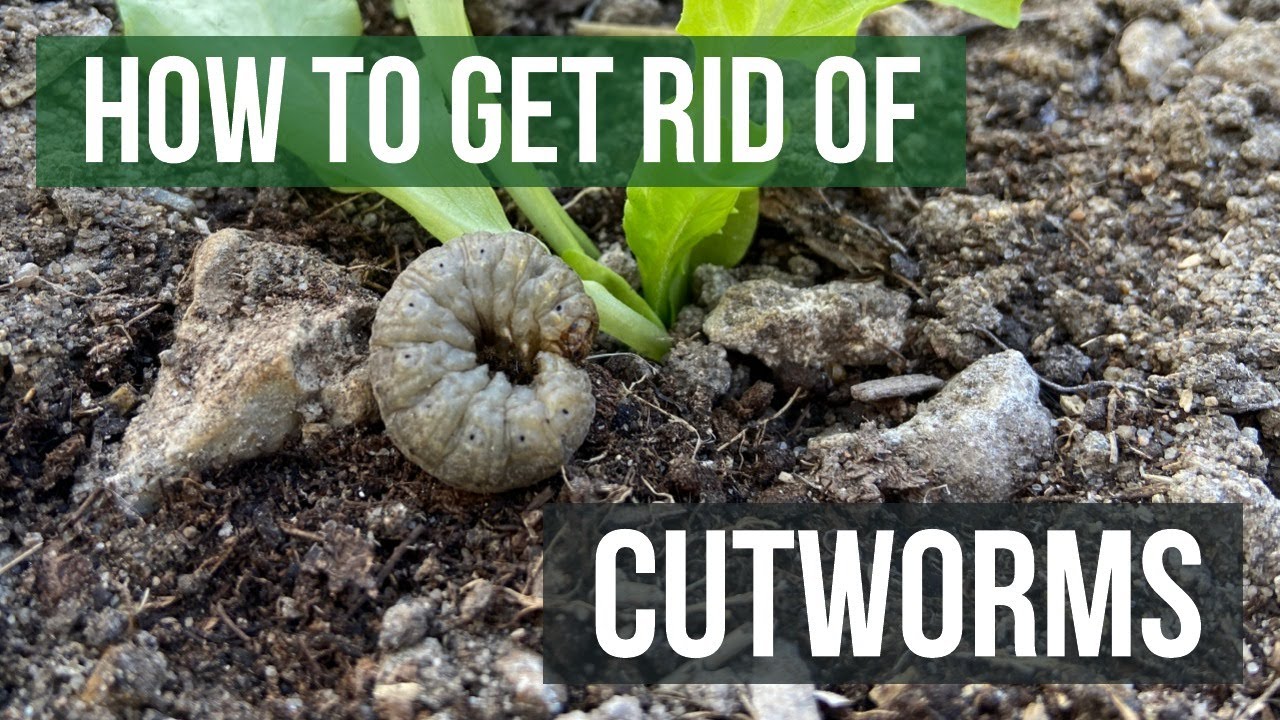To get rid of cutworms in your lawn, use natural methods like handpicking and trap cropping, or try applying organic insecticides. Cutworms can wreak havoc on your lawn, causing damage to young plants and grass.
Getting rid of them is crucial to maintaining a healthy and vibrant lawn.
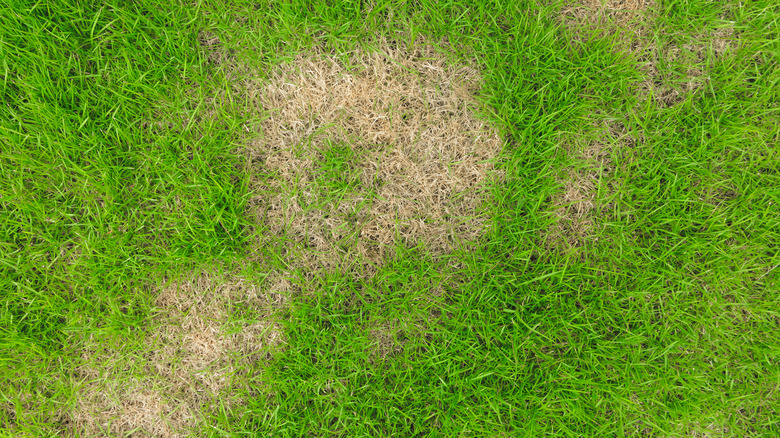
Credit: www.housedigest.com
Understanding Cutworms And Their Impact On Lawns
Cutworms can wreak havoc on your lawn, causing unsightly damage and potentially killing off your lush green grass. Understanding these pests and their impact on lawns is crucial in effectively combating them. In this section, we will delve into what cutworms are, why they are harmful to lawns, how to identify signs of a cutworm infestation, and the different types of cutworms and their characteristics.
What Are Cutworms And Why Are They Harmful To Lawns?
Cutworms are destructive caterpillar larvae that belong to the moth family. They are named for their habit of cutting down young plants at the base, often leaving behind severed stems. These pests are active during the night and hide in the soil during the day.
The harmful impact of cutworms on lawns stems from their feeding behavior. They can attack a variety of plants, including grass blades and seedlings, causing significant damage. When cutworms feed on grass blades, they create irregular patches of brown or dead grass, giving your lawn an unhealthy and unkempt appearance.
Additionally, cutworms can destroy young seedlings, hindering the growth and establishment of new plants.
Identifying Signs Of A Cutworm Infestation
Detecting a cutworm infestation early on is crucial to prevent further damage to your lawn. Here are some key signs to look out for:
- Irregular patches of brown or dead grass: Cutworms often feed on grass blades, resulting in patches of discolored or dead grass scattered across your lawn.
- Severed stems: Pay attention to plants that have been mysteriously cut down at the base. Cutworms leave behind severed stems as they feed.
- Presence of caterpillars: Keep an eye out for caterpillars in your lawn, particularly during the night. Spotting these pests can confirm a cutworm infestation.
Different Types Of Cutworms And Their Characteristics
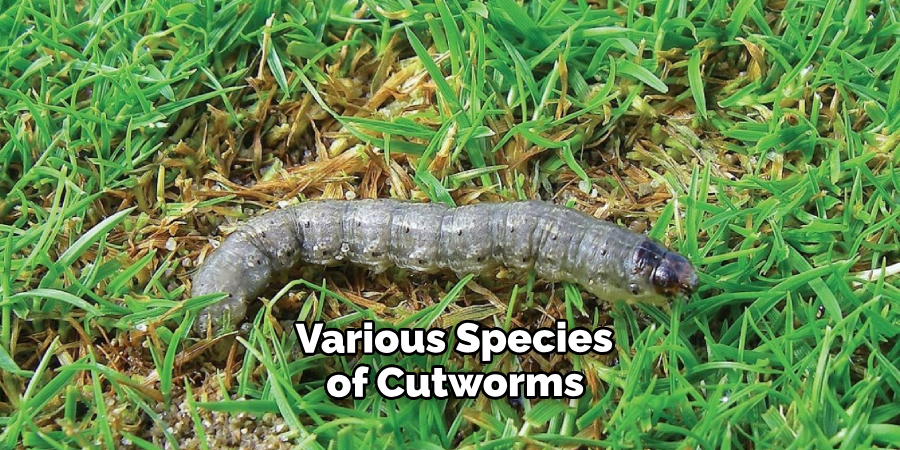
There are various species of cutworms, each with its own characteristics and preferences. Understanding the different types can help you effectively target and control them. Here are a few common ones:
- Black cutworm (agrotis ipsilon): These cutworms are mostly active in spring and early summer. They have a gray or black appearance and can grow up to 2 inches in length.
- Bronzed cutworm (nephelodes minians): These cutworms vary in color from light yellowish-brown to dark brown. They typically appear in late summer and fall.
- Variegated cutworm (peridroma saucia): As the name suggests, these cutworms have a distinct variegated pattern on their bodies. They are active during the spring and fall seasons.
By understanding the characteristics of different cutworm species, you can develop an effective strategy to combat them and protect your lawn from their destructive feeding habits.
Now that we have explored the basics of cutworms, their impact on lawns, and how to identify signs of an infestation, let’s proceed to the next section where we will discuss methods to get rid of these pesky pests. Stay tuned!
Preventive Measures To Minimize Cutworm Infestations
Maintaining Proper Lawn Care Practices To Reduce Cutworm Attraction
Implementing preventive measures in your lawn care routine can significantly reduce the risk of cutworm infestations. By following these key points, you can minimize the attraction of cutworms to your lawn:
- Regular mowing:
- Keep your lawn properly mowed to discourage cutworms from laying eggs in long grass.
- Maintain a recommended grass height of around 2-3 inches to deter cutworms from hiding.
- Proper watering:
- Water your lawn deeply and infrequently to promote strong, healthy grass roots.
- Avoid overwatering, as it can create an ideal environment for cutworms to thrive.
- Adequate fertilization:
- Apply balanced and timely fertilizers to ensure optimal lawn health.
- Avoid excessive nitrogen-rich fertilizers, as they can attract cutworms.
- Remove debris and thatch:
- Regularly remove dead leaves, clippings, and other organic matter from your lawn.
- Thatch, which is a layer of dead grass and debris, can provide a hiding place for cutworms. Raking or dethatching can help eliminate their hiding spots.
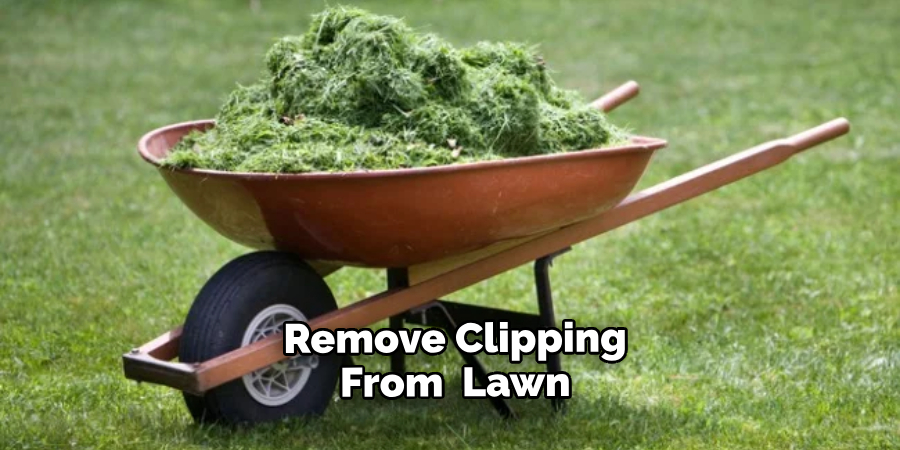
Implementing Effective Cultural Practices To Discourage Cutworms
Besides maintaining proper lawn care practices, incorporating certain cultural practices can further discourage cutworms. Consider the following points:
- Crop rotation:
- If growing vegetables or flowers in your garden, practice crop rotation to disturb the lifecycle of cutworms.
- By planting different types of plants each season, you disrupt cutworm’s ability to find their preferred food source consistently.
- Intercropping:
- Interplanting your garden with a variety of plants can help confuse and repel cutworms.
- Mixing plants with different scents, textures, and colors can disrupt cutworm’s feeding patterns and make your garden less appealing to them.
- Tilling the soil:
- In fall or early spring, lightly till the soil to expose cutworm pupae to natural predators and harsh weather conditions.
- This practice can help reduce cutworm populations before they emerge as damaging larvae.
Using Natural Predators To Control Cutworm Populations
Harnessing the power of natural predators is an effective and eco-friendly way to control cutworm populations. Consider these strategies:
- Attract beneficial insects and birds:
- Plant flowers that attract beneficial insects, such as parasitic wasps and ground beetles, which prey on cutworms.
- Provide birdhouses and bird feeders to encourage insect-eating birds like robins and chickadees that feed on cutworms.
- Beneficial nematodes:
- Apply beneficial nematodes, microscopic worms that feed on cutworm larvae, to your lawn and garden.
- These nematodes are available as commercial products and can significantly reduce cutworm populations.
- Biological insecticides:
- Use insecticides derived from naturally occurring bacteria, such as bacillus thuringiensis, to specifically target cutworms.
- Apply according to the product instructions, concentrating on areas where cutworms are present.
By implementing these preventive measures, cultural practices, and natural predators, you can create an environment that is less favorable to cutworms. This proactive approach will not only minimize potential damage to your lawn but also promote a healthier and more sustainable ecosystem.
Organic Methods For Eliminating Cutworms From Lawns
Cutworms can wreak havoc on your beautiful lawn, destroying your hard work and leaving unsightly patches in their wake. While chemical insecticides are an option, many homeowners prefer to take a more natural and eco-friendly approach to get rid of these pesky pests.
Thankfully, there are several organic methods you can use to eliminate cutworms from your lawn. In this section, we will explore three effective methods that do not involve the use of harsh chemicals.
Using Beneficial Nematodes To Kill Cutworms Naturally
Beneficial nematodes are a great organic solution for battling cutworms in your lawn. These microscopic worms are parasitic and feed on the cutworm larvae, effectively killing them. Here are the key points to consider when using beneficial nematodes:
- Purchase nematodes from a reputable supplier: Ensure that you buy nematodes from a trusted source to ensure their effectiveness.
- Apply nematodes in damp conditions: Nematodes are most effective when the ground is moist. Water the lawn before and after application.
- Follow application instructions: Each nematode product may have specific instructions for application. Read and follow them carefully.
- Apply nematodes in the evening: Applying nematodes during the evening or on cloudy days can increase their survival rate.
- Monitor and reapply if necessary: Keep an eye on the cutworm population and reapply nematodes if needed.
Applying Diatomaceous Earth As A Physical Barrier Against Cutworms
Diatomaceous earth is a natural powder made from the fossilized remains of diatoms, a type of hard-shelled algae. It acts as a physical barrier that slices through the cutworms’ bodies, dehydrating and killing them. Here are the key points to consider when applying diatomaceous earth:
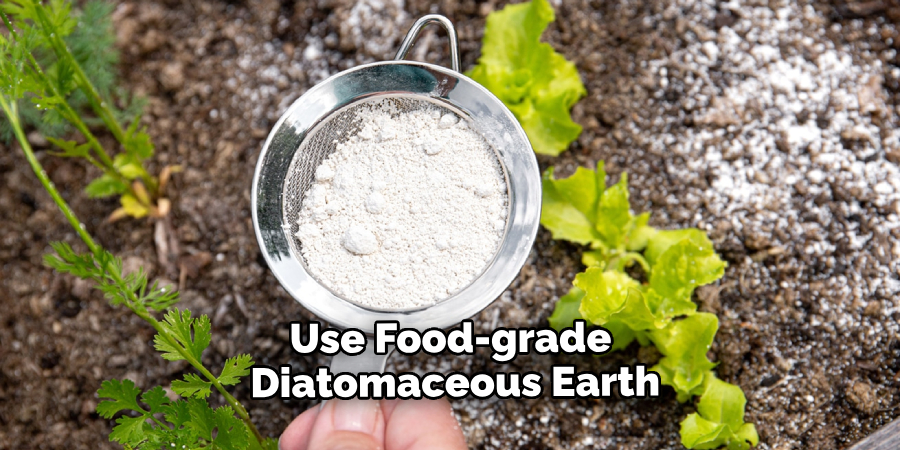
- Choose food-grade diatomaceous earth: Make sure you use food-grade diatomaceous earth, as other forms may contain harmful additives.
- Sprinkle it around the affected areas: Create a barrier by sprinkling diatomaceous earth around the perimeter of the lawn or specific areas where cutworms are active.
- Reapply after rain or watering: Diatomaceous earth needs to be reapplied after rainfall or watering to maintain its effectiveness.
- Wear protective equipment: When applying diatomaceous earth, wear a mask and gloves to avoid inhaling the fine powder.
Incorporating Botanical Insecticides In The Battle Against Cutworms
Botanical insecticides derived from plants can also be used to combat cutworm infestations. These natural compounds disrupt cutworms’ nervous systems, leading to paralysis and eventual death. Here are the key points to consider when incorporating botanical insecticides:
- Choose plant-based insecticides: Look for insecticides containing active ingredients such as pyrethrum, neem oil, or sabadilla.
- Follow application instructions: Read and follow the instructions provided by the manufacturer to ensure safe and effective application.
- Apply during evening hours: Apply botanical insecticides during the evening to minimize the impact on beneficial insects like bees and butterflies.
- Avoid excessive use: Use insecticides sparingly and only in areas where cutworm activity is concentrated.
By utilizing these organic methods, you can effectively eliminate cutworms from your lawn without harming the environment or exposing yourself, your family, or your pets to harsh chemicals. Remember to monitor the situation closely and adjust your approach if needed.
With patience and persistence, you can regain control of your lawn and say goodbye to those pesky cutworms for good.
Chemical Approaches For Cutworm Control
Understanding The Appropriate Use Of Chemical Pesticides
Cutworms can wreak havoc on your beautiful lawn, destroying all your hard work in a matter of days. While there are various methods available to control cutworms, using chemical pesticides is often the most effective way to eliminate these pesky pests.
But before diving into the world of chemical controls, it’s crucial to understand their appropriate use.
Here are the key points to consider when using chemical pesticides for cutworm control:
- Be aware of the potential risks: Chemical pesticides can be harmful to the environment, beneficial insects, and even pets if not used properly. It’s essential to understand the potential risks associated with their use and take necessary precautions to minimize any negative impact.
- Read and follow label instructions: Every pesticide comes with a label that provides detailed instructions on its proper use. Make sure to read and follow these instructions carefully to achieve the desired results while minimizing potential harm.
- Use pesticides as a last resort: Chemical control should only be employed when other less-toxic methods have failed or are impractical. This ensures that you are using pesticides responsibly and minimizing their impact on the environment.
- Limit pesticide application: Use pesticides only where and when necessary, focusing on the areas most affected by cutworms. Applying them unnecessarily can harm beneficial insects and disrupt the natural balance of your lawn ecosystem.
- Rotate pesticide treatments: To prevent cutworms from developing resistance to a specific pesticide, it’s crucial to use a rotation strategy. This involves switching between different pesticides with varying modes of action to maintain their effectiveness.
Choosing The Right Pesticide For Cutworm Control
With a plethora of pesticide options available, it can be overwhelming to choose the right one for cutworm control. However, by understanding the specific needs and characteristics of cutworms, you can narrow down the choices and invest in the most suitable pesticide.
Consider the following when choosing a pesticide for cutworm control:
- Targeted effectiveness: Look for pesticides specifically designed for cutworm control. These products usually contain ingredients that are highly effective against cutworms while minimizing harm to other beneficial organisms.
- Usage restrictions: Check the label of the pesticide to ensure it is approved for use in your area, and follow any usage restrictions or limitations mentioned. Different jurisdictions may have specific regulations regarding pesticide use.
- Application method: Evaluate the application method required for the pesticide. Some pesticides come in granular form, while others are available as liquid concentrates or ready-to-use sprays. Choose a formulation that aligns with your preferences and suits your lawn’s unique needs.
- Residual effects: Consider the residual effects of the pesticide you are considering. Some products offer long-lasting protection, while others may require more frequent reapplication. Assess your cutworm infestation severity and choose accordingly.
- Environmental impact: Opt for pesticides that have a minimal impact on the environment. Look for products labeled as environmentally friendly, organic, or low toxicity. This ensures that you are taking a responsible approach in safeguarding your lawn and the surrounding ecosystem.
Applying Pesticides Safely And Responsibly
Using chemical pesticides to control cutworms requires careful handling and responsible application. By following proper safety protocols, you can protect yourself, your family, and the environment.
Consider these safety measures when applying pesticides:
- Wear protective clothing: Always wear appropriate protective gear, including gloves, long-sleeved shirts, long pants, and closed-toe shoes, to minimize exposure to the pesticide.
- Mix and apply as directed: Follow instructions on the pesticide label for mixing and applying. Never exceed the recommended concentration or apply more than the specified amount. This prevents potential harm to your lawn, yourself, and the environment.
- Apply in suitable weather conditions: Avoid applying pesticides during windy or rainy conditions. Choose a calm day with no rain in the forecast to ensure proper coverage and minimize drift onto unintended areas.
- Keep children and pets away: Restrict access to treated areas until the pesticide has dried or settled completely. This prevents accidental exposure and ensures the safety of children and pets.
- Properly store and dispose of containers: Store pesticide containers securely in a cool, dry, and locked area, away from the reach of children and pets. Follow local regulations for the proper disposal of empty containers.
Remember, while chemical pesticides can be highly effective in controlling cutworms, their use should always be a last resort. Combine them with other integrated pest management strategies for a comprehensive approach to cutworm control and an environmentally friendly lawn.
Integrated Pest Management (Ipm) Strategies For Long-Term Cutworm Control
Cutworms can wreak havoc on your lawn, causing damage that is both frustrating and unsightly. To effectively combat these pests, it is important to implement a comprehensive integrated pest management (ipm) approach. By utilizing a combination of preventive, organic, and chemical methods, monitoring and assessing cutworm activity, and adjusting control methods based on efficacy, you can ensure long-term cutworm control.
Utilizing A Combination Of Preventive, Organic, And Chemical Methods
To effectively manage cutworms and prevent infestations in your lawn, it is essential to employ a multi-faceted approach that includes preventive, organic, and chemical methods. Here are key points to consider:
- Preventive methods:
- Remove weeds and dead plant matter to eliminate potential habitats for cutworms.
- Till the soil before planting to expose cutworms and disrupt their feeding patterns.
- Use physical barriers such as collars or cutworm-resistant plant varieties to protect young plants.
- Organic methods:
- Encourage natural predators like birds and beneficial insects that feed on cutworms by providing suitable habitats and food sources.
- Apply organic insecticides derived from botanical or microbial sources that target cutworms without harming beneficial organisms.
- Use nematodes, microscopic worms that attack cutworm larvae, as a biological control option.
- Chemical methods:
- Consider chemical insecticides as a last resort, applying them judiciously and following label instructions.
- Select specific insecticides that target cutworms and have minimal impact on beneficial insects and the environment.
- Rotate chemical control options to prevent cutworms from developing resistance to the insecticides.
Monitoring And Assessing Cutworm Activity To Determine The Effectiveness Of Control Measures
Regular monitoring and assessment of cutworm activity is crucial in evaluating the success of your control measures. Here’s what you need to know:
- Inspect your lawn regularly, especially during early morning or evening hours when cutworms are more active.
- Look out for signs of cutworm infestation such as damaged plants, cut stems, or chewed leaves.
- Consider using pheromone traps or light traps to monitor adult cutworm populations.
- Document and track the effectiveness of your control methods to identify patterns and make informed decisions.
Adjusting And Adapting Control Methods Based On The Success Or Failure Of Previous Attempts
Adaptability is key in long-term cutworm control. By adjusting your control methods based on the success or failure of previous attempts, you can optimize your strategies. Here are the key steps to follow:
- Regularly evaluate the effectiveness of your chosen control methods.
- If your current methods are successful, continue their implementation but remain vigilant for any signs of declining efficacy.
- If your control methods are not producing desired results, consider alternative approaches such as increasing the intensity or frequency of treatments.
- Learn from your experiences and make data-driven decisions to fine-tune your control strategies for long-term success.
By employing a combination of preventive, organic, and chemical methods, monitoring cutworm activity, and adapting your control methods based on previous outcomes, you can effectively manage these pests and maintain a healthy, cutworm-free lawn. Stay proactive, observant, and open to learning from your experiences to achieve long-term cutworm control.
Frequently Asked Questions On How To Get Rid Of Cutworms In Lawn
How Do Cutworms Damage Lawns?
Cutworms damage lawns by chewing through grass stems at ground level, causing wilting and eventual death of the grass. They can also cut off newly planted seedlings.
What Are The Signs Of A Cutworm Infestation In My Lawn?
Signs of a cutworm infestation include bare patches in the lawn, wilting or yellowing grass, and small green caterpillars curling up when disturbed. Look for cutworms near the soil surface at night.
How Can I Prevent Cutworms From Invading My Lawn?
To prevent cutworms, remove garden debris, keep lawns and gardens well-maintained, and avoid overwatering. Also, apply an insecticide labeled for cutworm control or use natural predators like birds and beneficial bugs.
When Is The Best Time To Treat My Lawn For Cutworms?
The best time to treat for cutworms is in early spring or late summer when they are most active. Apply a cutworm-specific insecticide or insecticidal nematodes to affected areas according to label instructions.
Can I Use Homemade Remedies To Get Rid Of Cutworms In My Lawn?
While homemade remedies like coffee grounds or cornmeal may deter some pests, they are not effective against cutworms. It is best to use insecticides or natural predators for effective cutworm control.
Are Cutworms Harmful To Pets Or Humans?
Cutworms are not harmful to humans or pets directly. However, the insecticides used to control them should be used cautiously and according to label instructions to avoid any potential risks.
Conclusion
Overall, getting rid of cutworms in your lawn can be a daunting task. However, by following the tips and strategies outlined in this blog post, you can effectively combat these destructive pests and restore the health and beauty of your lawn.
Start by identifying the signs of a cutworm infestation and implementing preventive measures, such as keeping your lawn well-maintained and using physical barriers. Additionally, using organic and natural pest control methods can help reduce cutworm populations without harming beneficial organisms or the environment.
Remember to regularly monitor your lawn for signs of cutworm activity and take prompt action if necessary. By staying proactive and implementing these techniques, you can regain control over your lawn and enjoy a pest-free outdoor space for years to come.
Say goodbye to cutworms and hello to a lush, thriving lawn!

